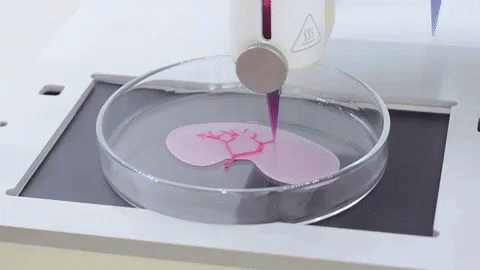Print yourself a new body part! Yes, with 3D printers entering the medical field; printing a new body part may soon be a widespread reality.
3D printers have been in use for making customized hearing aids, dental restorations, orthopedic splints, etc. The technology has also explored its application in patient care areas like prosthetic limbs, cranial implants, or orthopedic implants such as hips and knees. The demand for customized implants has been increasing due to the ability to efficiently create porous surface structures that facilitate osseointegration.
Another key area requiring personalization is pediatric surgery where implants and
equipment are difficult to standardize due to the size variation seen in children. An example is – a tracheal splint to treat newborns with tracheobronchomalacia. Here the splint size can be made personalized to the child. Enabling a better cure.
Another interesting application (found by engineers of RMIT, Australia) is that of ‘reverse’ 3D printing which is versatile enough to use medical-grade materials off the shelf. The approach involves printing glue molds that can then be filled with biomaterial filler. Once the mold is dissolved away, the biomaterial structure remains. Excitingly, the technique uses standard 3D printers and PVA glue as a printing material.
3D printers are now transforming to print materials beyond plastic, metal, and ceramic printing.
3D bioprinting is upcoming in tissue engineering, where organs and body parts are built using inkjet printing techniques. In this process, layers of living cells are deposited onto a sugar matrix (or gel medium) and slowly built up to form three-dimensional structures including vascular systems.
Researchers in China and the US have used this technique to print models of cancerous tumors. This has helped increase their understanding of tumors' development, growth, and spread. Thus, aiding in the discovery of new anti-cancer drugs. Bio-printed cancer models can even mimic the 3D heterogeneity of real tumors, thus revolutionizing personalized cancer therapy.
In India, Prayasta (a start-up) has innovated a new type of 3d printer - Silimac P250. It can print with implant-grade elastomers (especially silicone) for making personalized soft-tissue implants and prostheses. Their vision is to provide these printers to the hospital and enable doctors to get the required prints in real time.
Their industrial-level machine is meticulously designed to maintain the sterility of the printing environment and material.
The chemistry of implant-grade silicone brought about this innovation. In its natural form, ‘implant-grade’ silicone is a highly viscous liquid and cannot be converted to a filament or a powder. Furthermore, it has two components: a base polymer and a cross-linker. When both are mixed, a cross-linking reaction starts and this reduces the time available for printing. The material also requires real-time curing using IR laser & heaters to prevent structural collapse of the lower (uncured) layers from the weight of the freshly printed ones. The Silimac P250 overcomes all these hassles.
Their flagship products are breast implants & prostheses that are rupture resistant and fully personalized in shape, size, weight, touch, and feel. The personalization of breast implants would help reduce post-treatment complications such as back pain, poor posture, etc in breast cancer patients.
3D printing of tissues is a disruptive technology. It has made it possible for medical professionals to provide patients with a new form of treatment. This has led to the availability of lighter, stronger and safer healthcare products. As 3D printing technologies and materials continue to improve, they will pave the path for personalized care and high-impact medical applications.
https://www.prayasta.com/

Comments
Post a Comment